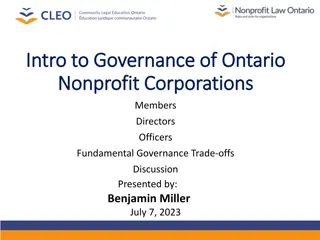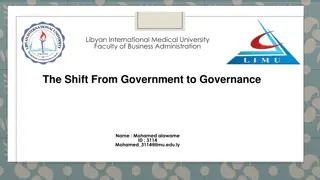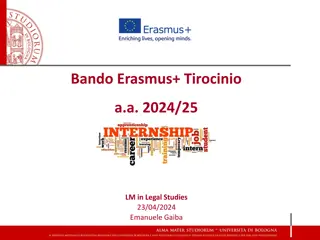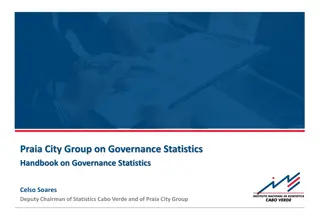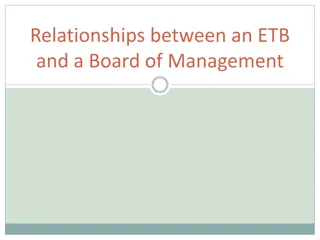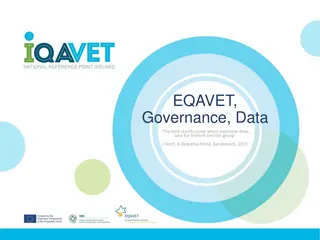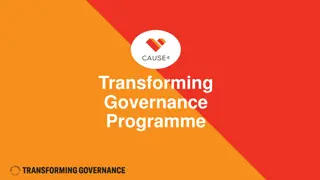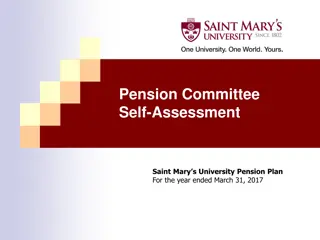Transforming Governance Programme by Cause4
Cause4 is a social business specializing in advice, fundraising, training, and programme development. Led by Michelle Wright, they offer expertise in governance and ACE's National Portfolio requirements. The Transforming Governance Programme, delivered in partnership with Arts Council England, focuses on effective leadership, strategy, recruitment, and implementing Investment Principles. Workshops cover topics like governance overview for charity/non-charity trustees, leading strategy, inclusivity, recruitment, and working with a board. Different types of organizations requiring governance are discussed, including charitable companies, trusts, CICs, universities, local authorities, and social enterprises.
Download Presentation

Please find below an Image/Link to download the presentation.
The content on the website is provided AS IS for your information and personal use only. It may not be sold, licensed, or shared on other websites without obtaining consent from the author.If you encounter any issues during the download, it is possible that the publisher has removed the file from their server.
You are allowed to download the files provided on this website for personal or commercial use, subject to the condition that they are used lawfully. All files are the property of their respective owners.
The content on the website is provided AS IS for your information and personal use only. It may not be sold, licensed, or shared on other websites without obtaining consent from the author.
E N D
Presentation Transcript
v Transforming Governance Programme
About Cause4 About Cause4 Cause4 is a social business and B-Corporation, specialising in advice, fundraising, training and programme development. Led by Michelle Wright, we have extensive expertise in governance and in-depth knowledge of ACE s National Portfolio requirements. Our three core programmes are the Trustee Leadership Programme, Arts Fundraising & Philanthropy and Heritage Compass. Transforming Governance Delivered in partnership with Arts Council England, Transforming Governance will strengthen governance by focussing on effective leadership, strategy, recruitment and implementing the Investment Principles (IPs).
Transforming Governance: Workshop Outline Workshop Structure Each workshop will be delivered via Zoom, lasting 90 minutes (50 minutes content, 15 minutes guest speaker, 15 minutes breakout task and 10-minute break). There are seven workshops in total. Workshop 1a: Overview of Governance for Charity Trustees Workshop 1b: Overview of Governance for Non-Charities Workshop 2: Leading and Overseeing Strategy Workshop 3: Governance and the ACE Investment Principles Workshop 4: Developing Inclusivity and Relevance Workshop 5: Recruitment of Trustees and Succession Planning Workshop 6: Working with a Board
v Workshop 1b: Overview of Governance for Non-Charity Trustees
Overview of Governance for Non-Charities Workshop 1b: Overview of Governance for non-charities e.g., CICs, Local Authorities and Universities Understanding governance in the cultural sector What is governance and why is it important? Key responsibilities of oversight and other non-charity boards Board Members and scrutiny responsibilities including strategic planning, financial oversight and legal Effective partnership and community working
Different Bodies that require governance There are many different types of organisation that come with different governing responsibilities: Charitable Company Trusts Charitable Incorporated Organisation Community Interest Company University Local Authority Social Enterprise
Legal Forms of Charities & Social Enterprises 1. Charitable Company This is a registered charity with limited liability bestowed on the directors or Trustees. The charitable company is responsible to both the Charity Commission and Companies House for its business. Charities can claim Gift Aid on donations received from individuals and companies can claim Corporation Tax Relief on donations made. This is currently the most popular form of governance arrangement and is relatively straightforward to administer, although the dual regulatory authorities make for some additional reporting requirements. 2. Trust Trusts are usually set up with a specific sum of money by a group of people who become its Trustees. This is often for a charity that distributes grants, where Trustees make decisions without involving a wider membership, and that will not employ staff or enter into contracts for work. Business is conducted in the name of the Trustees.
Legal Forms of Charities & Social Enterprises 3. Charitable Incorporated Organisation Recently introduced, this set of organisations is similar in nature to a charitable company. It reduces the administrative burden on charitable organisations through providing a structure which is responsible only to the Charity Commission but has its own legal identity (i.e. business is conducted in the name of the organisation not the Trustees themselves) and provides limited liability for the Trustees. CIOs are treated the same for tax purposes as registered charities. 4. Community Interest Company This is a type of limited company designed specifically for social enterprises, which operate predominantly for the benefit of the community rather than for the benefit of the owners of the company. There is an asset lock , meaning that a CIC cannot be used solely for the personal gain of a particular person, or group of people. Directors of CICs can be routinely paid for their services unlike charity or CIO Trustees. Unlike other charity types that report to the Charity Commission, CICs are regulated by the Office of the Regulator of Community Interest Companies, located within Companies House.
Other Bodies with Governing Boards 5. Universities Universities are governed through a system that typically involves a combination of key stakeholders, including a governing body often referred to as the Board of Governors or Council. This body is responsible for setting the strategic direction, overseeing the management of the institution, and ensuring it complies with legal and regulatory requirements. The Vice-Chancellor (or President) is the Chief Executive Officer equivalent who is responsible for the day-to-day management and administration of the institution and reports to the Board of Governors. Students often have a role in university governance, either through elected student unions or representation on university committees. They provide input on matters that affect students and campus life. 6. Local Authorities Local authorities in the UK are governed through a combination of elected representatives, administrative officials, and legal structures. These local councils, often with elected members, oversee various aspects of governance, with some areas having directly elected mayors or appointed leaders. Committees within the councils are responsible for specific functions, and a Chief Executive manages the day-to-day administration. Local government governance varies across the UK's four nations and is aimed at ensuring representation and effective service delivery in local communities.
Other Bodies with Governing Boards 7. Social Enterprises Social Enterprises are governed through a unique blend of business principles and a strong commitment to social or environmental missions. These organisations can take various legal forms, such as Community Interest Companies (CICs) or Companies Limited by Guarantee. The governance structure typically includes a board of directors or Trustees who are responsible for strategic decision-making and ensuring the organisation's social mission is upheld. Additionally, governing documents emphasise the social mission and the reinvestment of profits to achieve those objectives.
Quick Facts There are 921,364 Trustee positions held by 700,000 individuals in England and Wales, who are responsible for running 169,070 charities with a total income of 89.4bn (Charity Commission). Men outnumber women Board members two to one. The vast majority, 92%, are white British, and aged between 60-62 (20 years older than the average age in the UK). They are also above average in terms of both income and education.
Quick Facts As well as the 169,070 charities there are in the UK, there are many other universities, academies and independent schools, sports clubs, housing associations, trades unions and co-ops that comprise the broader body of Civil Society Organisations. As well as a charity Trustee, individuals can also become School Governors and Non-Executive Directors, serving a similar purpose for different organisations. It is estimated that there are 370,000 school governors who are members of 29,000 school governing bodies in the UK. There are 30,652 registered, active, CICs in England and Wales all with at least one Director.
Types of Board Member Trustee: A trustee is an individual responsible for overseeing and managing the affairs of a charitable organisation. Trustees have a legal duty to act in the best interests of the charity, ensure it fulfils its charitable purposes, and manage its resources effectively. They typically serve in a voluntary capacity and play a crucial role in governance, strategy, and decision-making within the charity. Non-Executive Director (Paid): A non-executive director (NED) is a member of a company's board of directors who is not part of the executive management team and is typically compensated for their service. NEDs provide independent oversight, guidance, and expertise to the company. They contribute to strategic decision-making and corporate governance.Their role is distinct from executive directors, who are actively involved in the day-to-day operations of the company.
Types of Board Member Director (of a CIC): A director of a Community Interest Company (CIC) is a member of the board responsible for the overall management and strategic direction of the CIC. While some directors may be compensated for their service, many serve in an unpaid capacity due to the CIC's social or community-oriented mission. CIC directors have a legal obligation to act in the best interests of the CIC and its community purpose. School Governor: A school governor is a volunteer who serves on the governing body of a school, helping to ensure its effective operation and the best possible education for students. School governors provide oversight, support, and challenge to the school's leadership team. They contribute to decision-making on matters like school policies, budgeting, and educational standards. Governors can include parents, staff, community members, and individuals with relevant expertise.
Types of Board Member University Board Member: A university board member is typically a member of the board of governors or a Trustee of a university. University board members are responsible for overseeing the institution's strategic direction, financial management, and adherence to educational standards and policies. They contribute to decisions related to academic programs, budgets, and the university's overall mission and objectives. These roles can be voluntary or paid, depending on the university and the specific position.
Governance Governance refers to the way in which organisations are directed, controlled and led. Strong governance is essential to the success of any organisation and Board Members must ensure that proper procedures and policies are in place to manage their resources effectively. Board Members should also provide a long-term vision for the organisation and protect its reputation and values.
Principles of Good Governance Clarity over the purpose and direction of an organisation an effective organisation is clear about its vision, mission and values, and uses them to direct its work; A strong Board an effective organisation is run by a clearly identifiable Board that has the right balance of skills and experience, acts in the best interests of the organisation and its beneficiaries, understands its responsibilities and has systems in place to exercise them properly; Fit for purpose the structure, policies and procedures of an effective organisation enable it to achieve its purposes and mission and deliver its services efficiently; Learning and improving an effective organisation is always seeking to improve its performance and efficiency, and to learn new and better ways of delivering its purposes, through self- assessment and external evaluation, which feed into planning processes and influence its future direction; Financially sound and prudent an effective organisation has the financial and additional resources needed to deliver its purposes and mission, and controls and uses them so as to achieve its potential; Accountable and transparent an effective organisation is accountable to the public and others, through easily understandable and transparent policies, procedures and practices.
Board Member Types In the arts, culture and heritage sector, there are a number of stereotypes often seen on Boards: Name-droppers Talk about their connections but never act on them; Seagulls Swoop in, make a mess and leave; Frustrated CEOs' - Those that want to run the organisation themselves; Glory-hunters - Don't do anything, but like their name on the letterhead Skills + Time + Energy + Culture
Governance vs. Management Governance Board s role Management Executive function How Boards make decisions, allocate resources, achieve results, and are held accountable Day-to-day management of tasks and details of running an organisation The Board has established clear levels of delegated authority within which: Some decisions are reserved to the board The CEO is empowered to make decisions and delegate authority to the staff for the day-to-day operation of the charity The CEO is required to escalate high risk and /or high impact issues for the timely attention and consideration of the board
Governance vs. Management in a CIC In the context of a Community Interest Company (CIC), governance and management are distinct, but there are interrelated aspects of how the organisation operates. When you are both a Director and a paid member of staff in a CIC, it's important to understand the differences between these roles: Governance: Governance refers to the overarching framework of rules, processes, and structures that guide how the CIC operates. It involves setting the strategic direction, making high-level decisions, and ensuring the organisation adheres to its mission and legal obligations. Duties typically include acting in the best interests of the CIC, avoiding conflicts of interest, and ensuring financial transparency. Management: Management focuses on the day-to-day operations of the CIC. It includes activities like planning, implementing strategies, managing resources, and supervising staff and operations. As a paid member of staff, you are involved in the management aspect of the CIC. You may have specific responsibilities related to your job, such as carrying out programmes, delivering services, or handling administrative tasks. Management is responsible for executing the strategic decisions made by the board of directors.
Governance vs. Management and Conflicts of Interest It's essential for individuals who hold both governance and management roles to manage potential conflicts of interest and to clearly understand their responsibilities in each capacity. Directors have a legal and custodial duty to the organisation and its stakeholders. As a paid staff member, your primary duty is to carry out your job responsibilities to the best of your ability.
Governance in Higher Education The Higher Education Governance Code outlines six interconnected elements that form the foundation for good governance. These elements work together to uphold core values and achieve objectives: Accountability: The governing body collectively bears responsibility for institutional activities, making final decisions on fundamental matters within its jurisdiction. Sustainability: The governing body, in collaboration with the Executive, establishes the institution's mission, strategic direction, and values. It ensures the sustainability of the institution by aligning the strategic plan with legal requirements, institutional values, policies, and effective control and risk management systems. Reputation: The governing body preserves and enhances the institution's reputation and autonomy by adhering to the values and principles in the Code, as well as the principles of public life. Equality, Inclusivity, and Diversity: The governing body fosters a positive culture that promotes ethical conduct, equality, inclusivity, and diversity throughout the institution, including within the governing body itself. It addresses under-representation and disparities in outcomes and takes corrective measures to ensure fairness. Effectiveness: The governing body ensures that governance structures and processes are robust, effective, and adaptable. It evaluates governance performance against the Code and recognised standards of good practice. Engagement: Governing bodies understand the institution's diverse stakeholders at global, national, and local levels. They ensure that meaningful engagement occurs, allowing stakeholder perspectives to inform relevant decision-making processes.
Organisational Structure The relationship between the Board, Chief Executive and Senior Management team is key. An organisation s management team acts as the conduit between governance decisions taken at Board level and the planning and organisational development plans which are based on these decisions. Management, staff and volunteers are a vital part of an organisation s assets and resources, and are essential to the effective delivery of an organisation s services to beneficiaries. It is important that Board members are aware of the organisation s legal obligations if they employ any members of staff and that they ensure that they have developed and put in place effective staff and volunteer management policies.
Strategic responsibilities of governance Setting a plan of action designed to achieve a long-term or overall aim. To lead, guide and support the organisation in its ongoing quest for sustainability and viability through strategic planning.
Financial responsibilities of governance Ensuring that accounts are subjected to internal scrutiny and any external scrutiny required by law or by the organisation s governing document; Ensuring that the accounts and annual return are filed on time with relevant regulatory bodies. Safeguarding the assets of the organisation and ensuring proper application of resources; Taking steps to prevent and detect bribery, fraud, financial abuse and other irregularities.
Legal responsibilities of governance Ensuring legal and statutory obligations that they are required are met. The board must meet all legal and regulatory requirements imposed on it and compliance should be kept under regular review. This will require awareness of: The law governing the type of organisation Laws governing its operation e.g. health and safety and employment law That conditions and obligations imposed by funding or regulatory bodies are met e.g. Arts Council England Common law duties such as providing a safe place to work are met Duties of loyalty, good faith and of care, diligence and skills are met
Financial Responsibility in a CIC Board members of a CIC have core financial responsibilities that they must adhere to: A CIC must maintain solvency, meaning it should be able to pay its debts as they become due. CICs are required to have an "asset lock" in place, which restricts the distribution of assets to members or shareholders. The financial activities and decisions of the CIC should align with their Community Interest Statement. A CIC must prepare and file an Annual Community Interest Report. There is a limit on the amount of dividends that can be paid to shareholders set by law. CICs are required to have their accounts audited in certain circumstances. They must also file annual financial statements and other financial reports with the Registrar of Companies and make them publicly available. Profits generated by the CIC should primarily be reinvested in its activities to achieve its social objectives. While some distribution of profits is allowed, it should not be the primary purpose of the company.
Financial Responsibility in a University Board members of a University have core financial responsibilities that they must adhere to: Universities are responsible for effective financial management, including budgeting, accounting, and financial reporting. They must ensure that their financial affairs are well-organised and transparent. Universities must manage the collection and processing of tuition fees from students in accordance with regulatory guidelines set out by Office for Students. Many universities engage in research activities and receive grants from various sources including Government. They must manage these funds responsibly and in accordance with grant agreements. Universities provide financial aid to students which must be administered fairly and transparently. Universities are required to produce annual financial statements and reports, subject to external audit. Many universities in the UK have charitable status, and they must comply with the rules and regulations associated with being a charitable organisation.
Board Performance To remain effective, every Board should review its own performance on a regular basis. By assessing the Board s effectiveness, organisations can identify any skills gaps and fill them as required. This will also ensure that the Board keeps in line with its own aims and objectives. The Chair is usually responsible for organising and overseeing internal reviews and audits, but all Board members should consider ways to increase effectiveness and efficiency. Some of the ways that a Board can assess its own effectiveness include: Away Days where the Board meet away from their regular location to discuss a particular issue; Strategy Meetings where the Board meet to scrutinise the strategic direction of the organisation; Interviews and Surveys where an appointed member interviews others about their effectiveness and conducts surveys. External facilitation in performance reviews can add credibility to the process. An independent facilitator can also provide anonymous feedback.
External Advisers If a Board does not feel adequately equipped to deal with a particular matter, they should consider engaging external advisers in order to fulfil their duty of care particularly where there is a material risk to the organisation, where land assets or large investments are at stake, or where the board members may be in breach of their duties. External advisers are able to provide fresh and different perspectives; an unbiased viewpoint; greater expertise; and broader experience. Some organisations may consider setting up an advisory board to formalise the relationship between an external adviser and the organisation. Advisory boards can make recommendations to the Board, but do not have any governing authority over the organisation.
Partnership Working Partnership working is an important aspect of good governance: Collaborative efforts allow non-charity organisations to pool resources, whether it's funding, expertise, or infrastructure, to address complex issues or undertake ambitious projects. Partnerships bring together organisations with different expertise and strengths. This diversity can enhance problem-solving and lead to more effective solutions. Working together can lead to a larger and more sustainable impact on the communities or causes these organisations serve, making it possible to achieve more significant outcomes. Non-charity organisations can share risks and liabilities with their partners, making it easier to tackle challenging events or invest in projects that may have higher risks. Collaborative environments encourage the exchange of ideas and best practices, promoting innovation and the development of new approaches to common challenges. Partnerships can lead to more efficient and cost-effective service delivery, particularly when addressing local or regional issues. Cost-sharing is a significant advantage of partnership working, as it allows organisations to reduce expenses, such as joint procurement or sharing infrastructure.
Partnership Working Non-charities like CICs and Local Authorities can achieve a more substantial and lasting impact on their communities by collaborating with other organisations, leading to positive social, environmental, or economic outcomes. Partnership working can stimulate economic development in local areas, benefiting non-charity organisations and the communities they serve by creating jobs and increasing economic activity. Local Authorities can partner with private businesses, CICs, or charitable organisations to leverage additional resources and investments for public initiatives and community development projects. Collaboration allows non-charities to share the costs of projects, infrastructure, or service provision, making the efficient use of limited budgets and reducing the financial burden on taxpayers. Non-charities, particularly Local Authorities, can benefit from partnerships that help them comply with regulatory requirements or industry standards, such as those related to environmental sustainability or service quality. Non-charities can access specialised knowledge and skills through partnerships, allowing them to deliver better services and respond to complex challenges effectively. CICs and Local Authorities can expand their capacity and service offerings by collaborating with organisations that complement their mission and objectives.
Key Markers of Successful Partnership Working Transparency: Partners are transparent about their objectives, resources, challenges, and decision- making processes. Transparency builds trust and reduces the likelihood of misunderstandings. Mutual Respect: Partners hold each other in high regard, valuing each other's expertise, contributions, and perspectives. Shared Values and Goals: When partners have a shared mission, it becomes easier to work together cohesively toward a common purpose. Clear Roles and Responsibilities: Partners clearly define their roles and responsibilities.. When everyone knows what is expected of them, it reduces confusion and potential conflicts. Effective Communication: Regular and clear communication is vital. Partners establish effective communication channels, including meetings, emails, and collaborative tools, to ensure that information flows freely. Equitable Balance: Partnerships should be equitable, with each party contributing to the extent of its capacity and resources. Agreed Terms of Reference: A well-defined partnership agreement or memorandum of understanding (MOU) can help clarify expectations, timelines, and responsibilities. Governance and Accountability: Establishing a clear governance structure and accountability mechanisms ensures that partners can track progress and maintain control over their contributions
Activating Partnerships Board Member's Role: Board members play a critical role in approving or overseeing major partnership decisions, including the approval of partnership agreements, budgets, and policies. They ensure that partnerships align with the organisation's Articles of Association, social mission, and regulatory compliance. Board members provide strategic guidance and monitor the partnership's impact on the organisation's mission, objectives, and financial sustainability
v Break
The Seven Deadly Sins of Boards John Williams, Civil Society, 2016
Discussion What Deadly Sins have you experienced or witnessed on Trustee Boards? What could be improved or implemented to help? Post 2-3 summary points in the chat post-session
v Transforming Governance Programme







